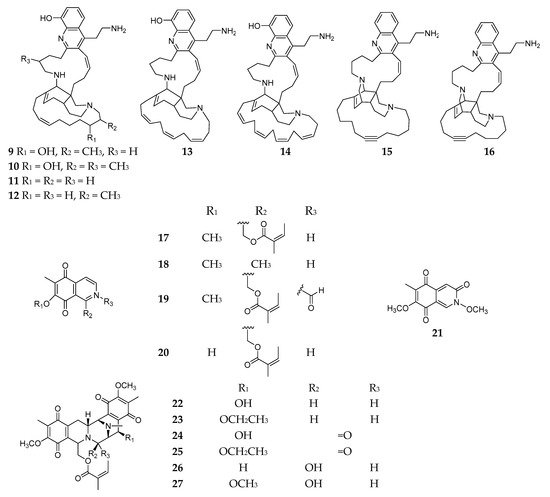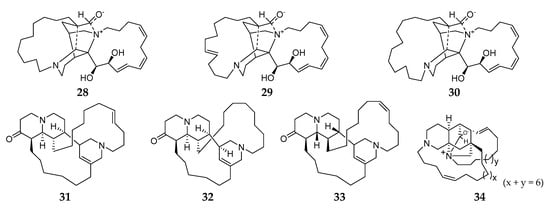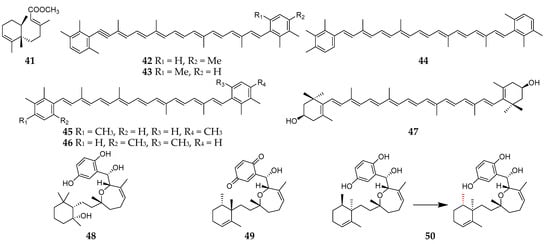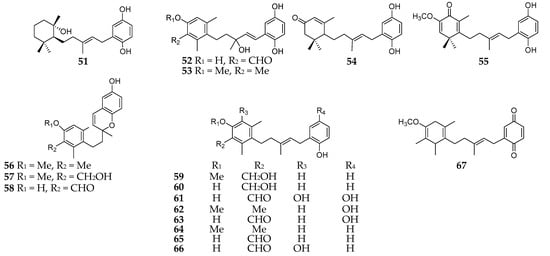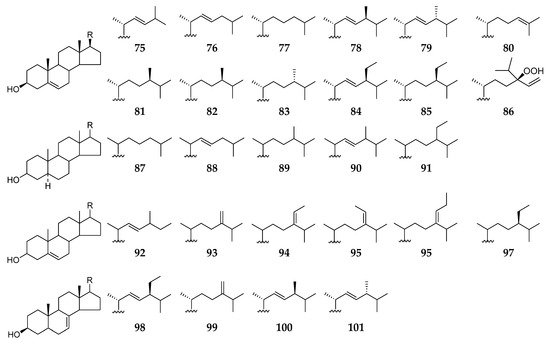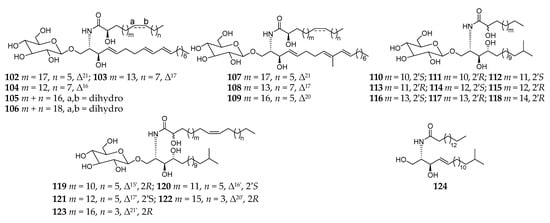Reniera is one subgenus of Haliclona sponges and has a soft texture and brownish-maroon epidermis, and its body looks like a compressed tree with simple digitate branches and spicules of various sizes and harbors a special arrangement of the flagellated chambers in the incurrent and excurrent canal systems.
1. Introduction
Marine sponges are widely distributed across oceans and represent one of the most diverse groups of primitive multicellular aquatic animals in nature. Numerous chemical investigations have indicated that this marine creature is one of the most attractive sources of precious natural products with the potential of clinical application
[1]. As one of the important marine sponges found in the Mediterranean Sea and Atlantic area,
Reniera was originally assigned as one genus and later classified to be one subgenus of
Haliclona [2]. Morphologically,
Reniera sponge has a soft texture and brownish-maroon epidermis, and its body is soft and fragile and looks like a compressed tree with simple digitate branches and spicules of various sizes
[3]. Meanwhile, this marine sponge harbors a special arrangement of the flagellated chambers in the incurrent and excurrent canal systems
[3]. To the best of our knowledge, the subgenus
Reniera consists of at least 16 species, including
R. albescens,
R. coccinea,
R. cratera,
R. fallaciosa,
R. fascigera,
R. fragilis,
R. fulva,
R japonica,
R. lacteal,
R. membrana,
R. mucosa,
R. porosa,
R. porrecta,
R. reticulata,
R. sarai, and
R. thomasii [4].
2. Natural Product Inventory of the Subgenus Reniera
Chemical studies of the marine sponge subgenus Reniera date back to the early 1970s. Until 2020, as many as 121 natural products had been isolated and characterized from Reniera sponges and their endozoic microbes. According to their chemical structures, these biomolecules are grouped into five types including alkaloid, terpenoid, polyketide, sterol, and cerebroside and ceramide, which are respectively introduced in detail as follows.
2.1. Alkaloids
2.1.1. 3-Alkylpyridiniums
Reniera sponge-derived 3-alkylpryridiniums are inseparable dimers or polymers with various degrees of polymerization (DP) and different lengths of alkyl chains. Usually, polymeric 3-alkylpyridinium salt (Poly-APS) possesses a broad spectrum of biological properties, including a potent inhibitory effect on acetylcholinesterase and phosphatase 2A, and cytotoxic, hemoclasis, and proarrhythmogenic activity
[5][6][7][8][9][10][11][12][13]. Moreover, these natural products had been found to inhibit microfouling, and the proliferation and movement of susceptible algae and biofilm bacteria
[14][15][16]. The chemical study of
Reniera sp. collected from Pemba Island (Tanzania) afforded three novel cyclic 3-alkylpyridiniums named njaoaminiums A (
1), B (
2), and C (
3) (), of which compound
2 has weak cytotoxicity against three human tumor cell lines A549 (lung carcinoma), HT29 (colon carcinoma), and MDA-MB-231 (breast) with GI
50 values of 4.1, 4.2, and 4.8 μM, respectively
[17]. Two cyclic poly-APSs (
4 and
5) with a respective DP of 29 and 99 were separated and characterized from the Mediterranean specimen of
R. sarai [18]. One search for the chemical synthesis of poly-APS resulted in the production of three novel analogs APS8 (
6), APS12-2 (
7), and APS3 (
8), of which compound
8 is a mixture of two polymers with DPs of 10 and 32 covalently linked
N-butyl-3-butyl pyridinium units in a 9:1 ratio. Bioassay suggested that compound
6 exhibited a toxic effect on the non-small cell lung cancer (NSCLC) tumor cell line but nontoxicity against normal lung fibroblasts
[9], while
7 could cause vascular smooth muscle contraction and a decrease in arterial blood pressure and
8 could block muscle-type nicotinic acetylcholine receptors (nAChRs)
[19][20].
Figure 1. 3-Alkylpyridiniums 1–5 from the subgenus Reniera and their derivatives 6–8.
2.1.2. Quinolines and Isoquinolines
Bioassay fractionation of the 2-propanol crude extract of
Reniera sp. collected from the Njao area (Tanzania) afforded eight new polycyclic quinolines and njaoamines A–G and I (
9–
16) (); compounds
9–
14 demonstrated potent cytotoxicity against human tumor cell lines colon H-T29, lung A-549, and breast MDA-MB-231 with GI
50 values ranging from 1.5 to 7.2 μM; and compound
16 had cytotoxic effect on three human tumor cell lines including MDA-MB-231 (breast), HT-29 (colon), and NSLC A-549 in the micromolar range
[21][22]. Chemical analysis of the similar specimen collected in Isla Grande (Mexico) afforded nine antimicrobial isoquinolines (
17–
25), including five monomers renierone (
17), 7-methoxy-1,6-dimethyl-5,8-dihydroisoquinoline-5,8-dione (
18),
N-formyl-1,2-dihydrorenierone (
19),
O-demethylrenierone (
20), and mimosamycin (
21), and four dimers renieramycins A–D (
22–
25)
[23][24]. In addition, two new polycyclic isoquinoline dimers, renieramycins E (
26) and F (
27), were purified from another
Reniera specimen collected from Palau
[25].
Figure 2. Quinolines and isoquinolines 9–27 from the subgenus Reniera.
2.1.3. Macrocyclic Diamines
To the best of our knowledge, all macrocyclic diamine-producing
Reniera sponges were collected from the Mediterranean. Saraines A–C (
28–
30) () were obtained from the Mediterranean sponge
R. sarai and exhibited a broad spectrum of biological activities, including insecticidal and acaricidal potency to the arthropoda
Macrosiphum euphorbiae (Thos.),
Tetranychus urticae Koch, and
Aedes aegypti L.; strong inhibitory effect on
Streptococcus agalactiae and AChE; and high hemolysis
[26][27][28]. Chemical synthesis of compound
28 had first been achieved by Garg and coworkers in 2006
[29]. Isosaraine-1–3 (
31–
33) were three new hexahydro-quinolizin-2(6
H)-one derivatives and their absolute stereochemistry was unambiguously determined using the modified Mosher’s method
[30][31][32]. One novel macrocyclic alkaloid, misenine (
34), was purified from unclassified
Reniera sponge collected in the Bay of Naples (Italy)
[33]. Unfortunately, no report of their bioactivity has been published until now.
Figure 3. Macrocyclic diamines derivatives 28–34 from the subgenus Reniera.
2.1.4. Other Alkaloids
A search for antimicrobial substance(s) from an unidentified
Reniera sponge from Isla Grande (Mexico) led to the isolation of one new isoindole-4,7-dione derivative (
35) ()
[24], which was chemically synthesized through the cycloaddition of a nonstabilized azomethine ylide and a quinone by Parker and coworkers in 1984
[34]. Chromatography on a column of a cation exchange resin of the
n-butanol soluble fraction from the acetone extracts of the sponge
R. cratera afforded one simple nitrogenous compound 2-aminoimidazole (
36)
[35]. One cyclic depsipeptide renieramide (
37) was also isolated and characterized from
Reniera sp. No. 2115 collected on the Island of Santo (Vanuatu)
[2]. Bioassay-guided fractionation of the MeOH extract of one marine sponge
Haliclona (
Reniera) sp. collected off Ulleung Island (Korea) led to the discovery of a new sphingosine (
38) together with two lysophosphatidylcholines (
39 and
40), which exhibited moderate cytotoxicity against a panel of five human solid tumor cell lines including A549, SK-OV-3, SK-MEL-2, XF498, and HCT15
[36].
Figure 4. Other alkaloids derivatives 35–40 from the subgenus Reniera.
2.2. Terpenoids
Structurally, most of terpenoids produced by
Reniera sponges are tetraterpenes except the sesquiterpenoid fulvanin 1 (
41) ()
[37]. Interestingly, these tetraterpenes are carotenoid analogs, including acetylenic carotenoids (
42–
43), renieratene (
44), isorenieratene (
45), and renierapurpurin (
46) from
R. japonica [38][39]. It is noteworthy that two symbiotic strains,
Flexibacter sps. DK30213 and DK30223, isolated from
R. japonica, were found to produce zeaxanthin (
47), which is one of the commonly used antioxidant agents
[40]. Two new cytotoxic meroditerpenes, halioxepine B (
48) and halioxepine C (
49), along with halioxepine (
50), were isolated from two Indonesian sponges of the genus
Haliclona (
Reniera) and structurally determined by QM/NMR-DFT (quantum mechanics combined with nuclear magnetic resonance parameters calculated by density functional theory approximations) analysis
[41]. It is noteworthy that compound
50 had first been synthesized and the absolute configuration at position C15 was revised as
S [42].
Figure 5. Terpenoids 41–50 from the subgenus Reniera.
2.3. Polyketides
2.3.1. Aromatic Polyketides
Polyketides are one of the major groups of
Reniera-derived secondary metabolites, such as aromatic and aliphatic polyketides. As many as eighteen aromatic polyketides (
51–
67) () had been separated from
R. fulva and
R. mucosa, which were respectively collected from the Egadi Islands (Italy) and Tarifa Island (Spain)
[37][43]. Compounds
52,
53,
56, and
59 possessed in vitro cytotoxicity against P388 mice lymphoma, A549 human lung carcinoma, HT29 human colon carcinoma, and MEL28 human melanoma cell lines with the same ED
50 values of 5 mg/mL
[43]. Moreover, compound
59 exhibited a moderate inhibitory effect on DHFR (dihydrofolate reductase) with an ED
50 value of 3 mg/mL. At the concentrations from 10
−4 to 10
−8 M, compounds
61 and
63 were shown to be cytotoxic to the NCI-H522 nonsmall lung cancer cell line and CCRF-CEM leukemia cell line, while
54 had more selective cytotoxicity against the latter
[37].
Figure 6. Aromatic polyketides derivatives 51–67 from the subgenus Reniera.
2.3.2. Aliphatic Polyketides
Linear alkynols and alkynones are the most common aliphatic polyketides detected in the marine sponge
R. fulva. Fulvinol (
68, ), a new long-chain diacetylenic compound, was purified from
R. fulva collected at Algeciras Bay (Spain) and found to possess an inhibitory effect on P-388 mouse lymphoma, A-549 human lung carcinoma, HT-29 human colon carcinoma, and MEL-28 human melanoma cell lines with the same ED
50 values of 1 μg/mL
[44]. One search for secondary metabolites of
R. fulva from the Mediterranean Sea resulted in the isolation of five new acetylenic compounds including debrorenierin-1 (
69), renierin-1 (
70), lb-dihydrorenierin-1 (
71), renierin-2 (
72), and 18-hydroxyrenierin-2 (
73)
[45].
Figure 7. Aliphatic polyketides 68–73 from the subgenus Reniera.
2.3.3. Other Polyketide
One new bicyclic eicosanoid named mucosin (
74) () was detected in the acetone extracts of
R. mucosa samples, which had been collected in different areas including Blanes (Spain), Grotte de Jarr (France), Massalubrense, and Procida (Italy)
[46]. Interestingly, this metabolite contains an unusual bicyclo [4.3.0] nonane skeleton with equilibrium of normal physiology in mammalian systems.
Figure 8. Other polyketide 74 from the subgenus Reniera.
2.4. Sterols
To date, a total of 27 sterol derivatives (
75–
101) () have been obtained and characterized from
Reniera sponges. Chemical analysis of one unidentified sample (#063176) deposited at California Academy of Sciences Museum afforded eleven sterols (
74–
85)
[47], and another specimen (
R. sarai) collected from the Bay of Naples (Italy) resulted in the isolation of ten sterols (
87–
96)
[48]. Using vacuum liquid chromatography (VLC), flash column chromatography, and preparative thin-layer chromatography (PTLC),
β-sitosterol (
97) was purified from ethyl acetate extract of
Haliclona (Reneira)
fascigera sponge (SPV06/12/13) collected off Samalona Island (Indonesia)
[49]. Along with three alkaloids (
38–
40), six sterol analogs
77,
86, and
98–
101 were separated from the MeOH extract of the sponge
Haliclona (
Reniera) sp. J01U-6 from Ulleung Island (Korea)
[36].
Figure 9. Sterols 75–101 from the subgenus Reniera.
2.5. Cerebrosides and Ceramide
Cerebrosides are a group of glycosphingolipids consisting of a glucose or galactose residue attached to a ceramide moiety containing one sphingoid base and an amide-linked long fatty acyl chain. These amphipathic biomolecules are important components of tissues and organs in organisms and possess a broad spectrum of biological functions such as antifungal, antitumor, antiviral, an inhibitory effect on histidine decarboxylase, and cytotoxicity
[50]. Chemical analysis of the
n-hexane layer of the MeOH extract of the same specimen
Haliclona (
Reniera) sp. J01U-6 collected off the coast of Ulleung Island (Korea) afforded twenty-one new cerebrosides (
101–
111,
113–
122) together with one known analog (
112), which possess unprecedented unsaturated or saturated long (C
15–C
28) alkyl chains ()
[51][52]. This was the first report on the isolation of isomeric pairs of glucocerebrosides containing saturated C
15 and C
19 acyl chains. Lately, the structural determination of compounds
109–
112,
115,
116,
120, and
121 were well established using fast atom bombardment mass spectrometry (FAB-MS) in positive-ion mode by Hong and coworkers
[53]. In addition, one ceramide (
123) was separated from the same sponge SPV06/12/13 collected off Samalona Island, and its absolute structure was determined by HyperChem computational techniques
[49].
Figure 10. Cerebrosides 102–123 and ceramide 124 from the subgenus Reniera.


